Stress Loss Analysis of a Geotechnical Prestressed Anchor under a Corrosive Environment in a Coastal Area
Abstract
1. Introduction
2. Materials and Methods
2.1. Anchor Rod Materials
2.2. Experimental Instruments
2.3. Sensor Layout
2.4. Anchor Rod Test Sample and Anchorage
2.5. Experimental Scheme
2.5.1. Simulation Test under Corrosion Environment
2.5.2. Loading and Measuring Method
2.5.3. Stress Loss Experiments of The GFRP Bolt Structure under Different Erosion Environment
2.5.4. Stress Loss Experiments of Prestressed Anchor Structures under Different Load Levels in Alkaline Environment
2.5.5. The Influence of Corrosion Degree on Bolt Stress
2.5.6. The Prestressed Anchor Cable Is Buried in the Rock and Soil
3. Results
3.1. Overall Stress Loss Characteristics of thePrestressed Anchor Rod
3.2. Variation inElastic Modulus of the Anchor Rod
3.3. Effect of Corrosion on the Stress on the Prestressed Anchor Rod
3.4. Effect of Corrosion on the Shear Stress on the Anchor Bolt–Grouting Body
3.5. The Corrosion Morphology of the Prestressed Anchor Rod under Different pHValues
3.6. Effect of Oxygen Concentration on the Stress Loss of the Prestressed Anchor Rod
4. Discussion
- (1)
- Inthe early stage of corrosion, the stress loss of the prestressed anchor rod is large. The more serious the marine climate corrosion is, the more serious the prestress loss of the anchor rod is.
- (2)
- Stress loss leads to a decrease inthe single-line modulus. When the corrosion is more serious, the elastic modulus is relatively lower.
- (3)
- The increase in corrosion degree leads to the gradual decrease in stress on the prestressed anchor rod.
- (4)
- The influence of corrosion on the shear stress on the anchor–grouting body is similar to that in (3).
- (5)
- In the simulated marine climate environment, the higher the alkalinity of the solution is, the more serious the corrosion morphology of the prestressed anchor rod is. This is because there is residual acid liquid on the surface and internal microholes of the metal anchor material. The higher the alkalinity of the solution, the more likely the anchor rod is to undergo the second corrosion, thus reducing the surface adhesion of the specimen. The corrosion of the surface morphology of the anchor rod inevitably affects its overall performance.
- (6)
- In addition to the corrosion of the anchor rod caused by the alkaline solution, oxygen oxidation also leads to the corrosion of the anchor rod. Therefore, the influence of the oxygen rate on the stress loss of the prestressed anchor rod is verified.
5. Conclusions
Author Contributions
Funding
Institutional Review Board Statement
Informed Consent Statement
Data Availability Statement
Conflicts of Interest
References
- Dias-Da-Costa, D.; Neves, L.; Gomes, S.; Hadigheh, S.A.; Fernandes, P. Time-dependent reliability analyses of prestressed concrete girders strengthened with cfrp laminates. Eng. Struct. 2019, 196, 109297.1–109297.11. [Google Scholar] [CrossRef]
- Lee, S.; Kim, Y.; Ko, M.; Lee, C. Assessment of thermal prestress loss with re-tensioning tests. ACI Struct. J. 2019, 116, 87–96. [Google Scholar] [CrossRef]
- Heydarinouri, H.; Motavalli, M.; Nussbaumer, A.; Ghafoori, E. Development of mechanical strengthening system for bridge connections using prestressed cfrp rods. J. Struct. Eng. 2021, 147, 04020351. [Google Scholar] [CrossRef]
- Shi, K.; Wu, X.; Liu, Z.; Dai, S. Coupled calculation model for anchoring force loss in a slope reinforced by a frame beam and anchor cables. Eng. Geol. 2019, 260, 105245. [Google Scholar] [CrossRef]
- Chen, Y.; Yan, J.; Sareh, P.; Feng, J. Feasible prestress modes for cable-strut structures with multiple self-stress states using particle swarm optimization. J. Comput. Civ. Eng. 2020, 34, 04020003. [Google Scholar] [CrossRef]
- Tong, T.; Hua, G.; Liu, Z.; Liu, X.; Xu, T. Localizing gradient damage model coupled to extended microprestress-solidification theory for long-term nonlinear time-dependent behaviors of concrete structures. Mech. Mater. 2020, 154, 103713. [Google Scholar] [CrossRef]
- Wang, S.R.; Wang, Y.H.; Gong, J.; Wang, Z.L.; Huang, Q.X.; Kong, F.L. Failure mechanism and constitutive relation for an anchorage segment of an anchor cable under pull-out loading. Acta Mech. 2020, 231, 3305–3317. [Google Scholar] [CrossRef]
- Zhu, B.; Li, Q.; Wu, Y.; Li, J. Analytical model for predicting stress distribution and load transfer of tension-type anchor cable with borehole deviation. Int. J. Geomech. 2020, 20, 04020085. [Google Scholar] [CrossRef]
- Wang, X.; Zhou, J.; Ding, L.; Song, J.; Wu, Z. Static behavior of circumferential stress-releasing anchor for large-capacity frp cable. J. Bridge Eng. 2020, 25, 04019114. [Google Scholar] [CrossRef]
- Tian, Z.C.; Peng, W.P.; Zhang, J.R.; Jiang, T.Y.; Deng, Y. Determination of initial cable force of cantilever casting concrete arch bridge using stress balance and influence matrix methods. J. Cent. South Univ. 2019, 26, 3140–3155. [Google Scholar] [CrossRef]
- Mokhtari, M.; Barkhordari, K.; Abbasi, S. Comparative study of the seismic response of soil-nailed walls under the effect of near-fault and far-fault ground. J. Geol. 2020, 13, 121–146. [Google Scholar]
- Takase, Y. Testing and modeling of dowel action for a post-installed anchor subjected to combined shear force and tensile force. Eng. Struct. 2019, 195, 551–558. [Google Scholar] [CrossRef]
- Kumar, V.K.; Ilamparuthi, K. Performance of anchor in sand with different forms of geosynthetic reinforcement. Geosynth. Int. 2020, 27, 1–68. [Google Scholar]
- Chen, J.; Guo, Y.; Zhang, L. A glass-fiber packaged fiber bragg grating strain sensor. Laser Optoelectron. Prog. 2020, 57, 54–59. [Google Scholar]
- Wang, S.; Zhu, Y.; Ma, W.; Wang, Z.; Li, G. Effects of rock block content and confining pressure on dynamic characteristics of soil-rock mixtures. Eng. Geol. 2021, 280, 105963. [Google Scholar] [CrossRef]
- Yang, Q.; Cong, B.; Wang, Z.; Yu, L. An analytical solution for the ultimate embedment depth and potential capacity of vertically loaded anchors with a bridle shank. Ocean Eng. 2019, 187, 106216.1–106216.17. [Google Scholar] [CrossRef]
- Liu, Z.; Xia, X.; Zhang, Y.; Jiang, J. Damage behavior of ultra-high performance concrete under load-temperature coupling. J. Chin. Ceram. Soc. 2021, 49, 1238–1246. [Google Scholar]
- Bujnak, J.; Mecar, J.; Bahleda, F. Tensile resistance of an anchor plate with supplementary reinforcement. Struct. Concr. 2019, 20, 164–170. [Google Scholar] [CrossRef]
- Wang, C.; Wang, X.; Chen, X.; Yu, G. Maximum vertical pullout force of torpedo anchors in cohesive seabeds at different steady pullout velocities. J. Coast. Res. 2020, 36, 1. [Google Scholar] [CrossRef]
- Lin, Y.L.; Lu, L.; Yang, G.L. Seismic behavior of a single-form lattice anchoring structure and a combined retaining structure supporting soil slope: A comparison. Environ. Earth Sci. 2020, 79, 78. [Google Scholar] [CrossRef]
- Zhe, Z.; Yang, Z.; Ping, Z. Flexural behavior of precast RC deck panels with cast-in-place UHPFRC connection. Coatings 2022, 12, 1183–1189. [Google Scholar]

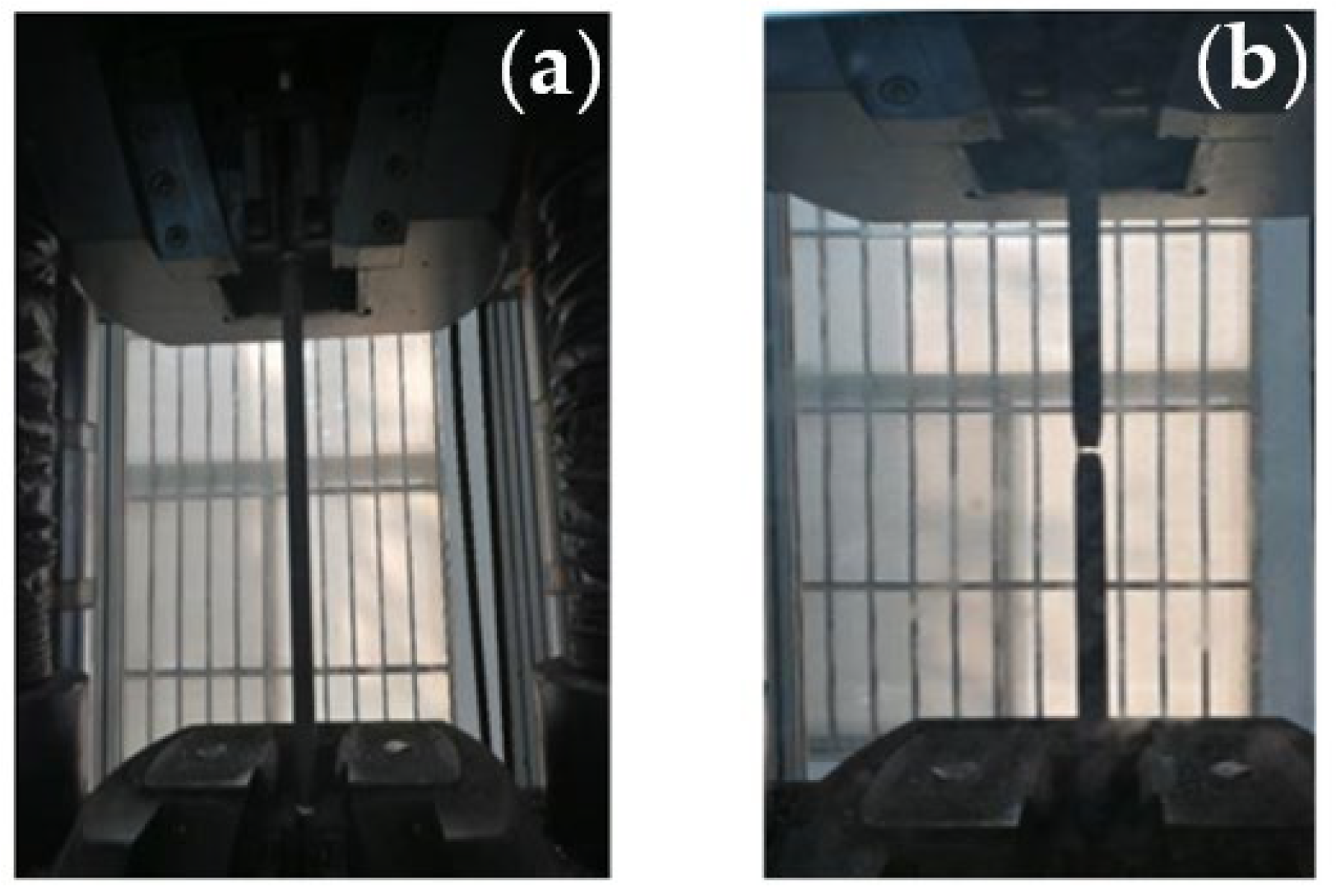
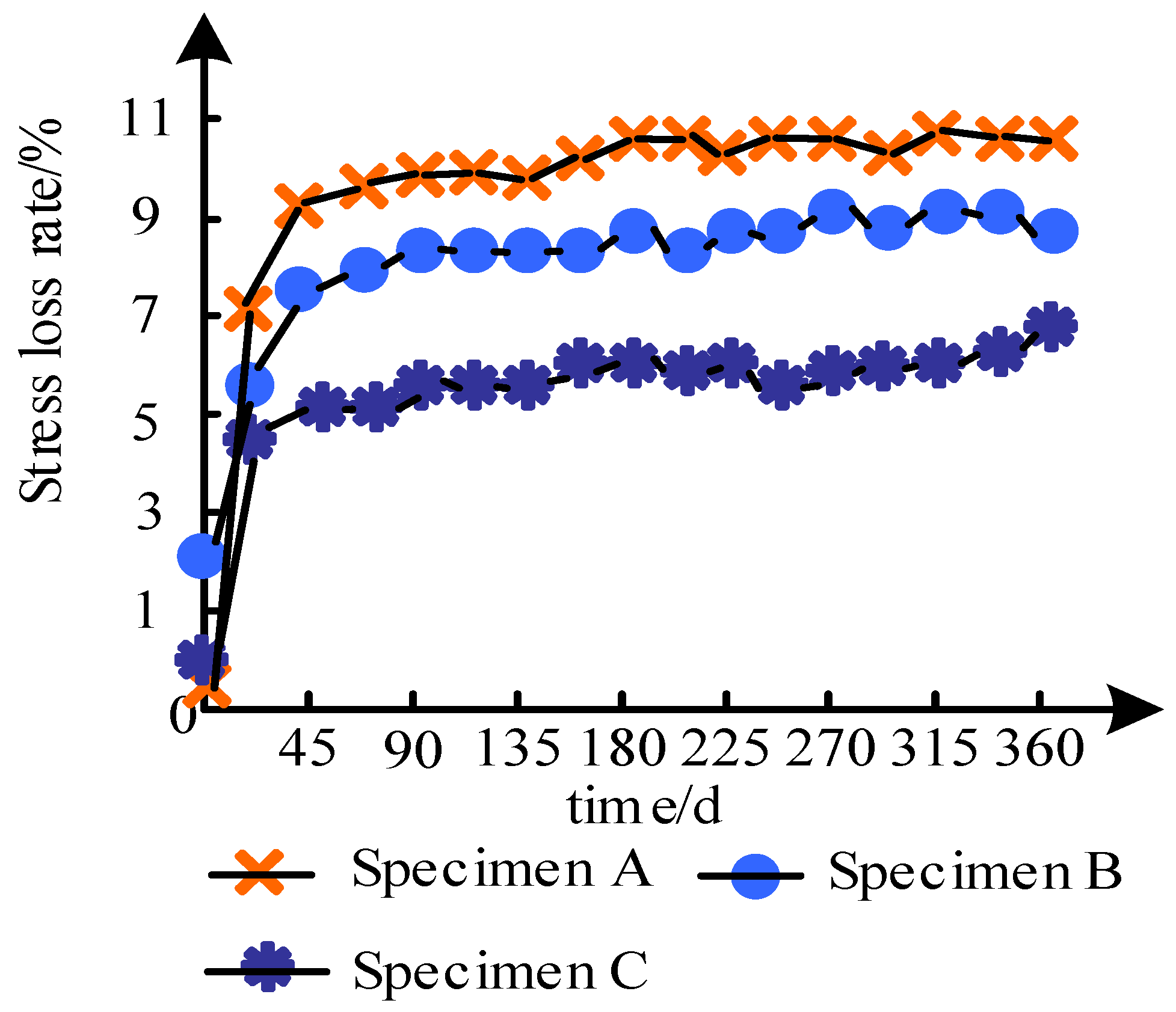
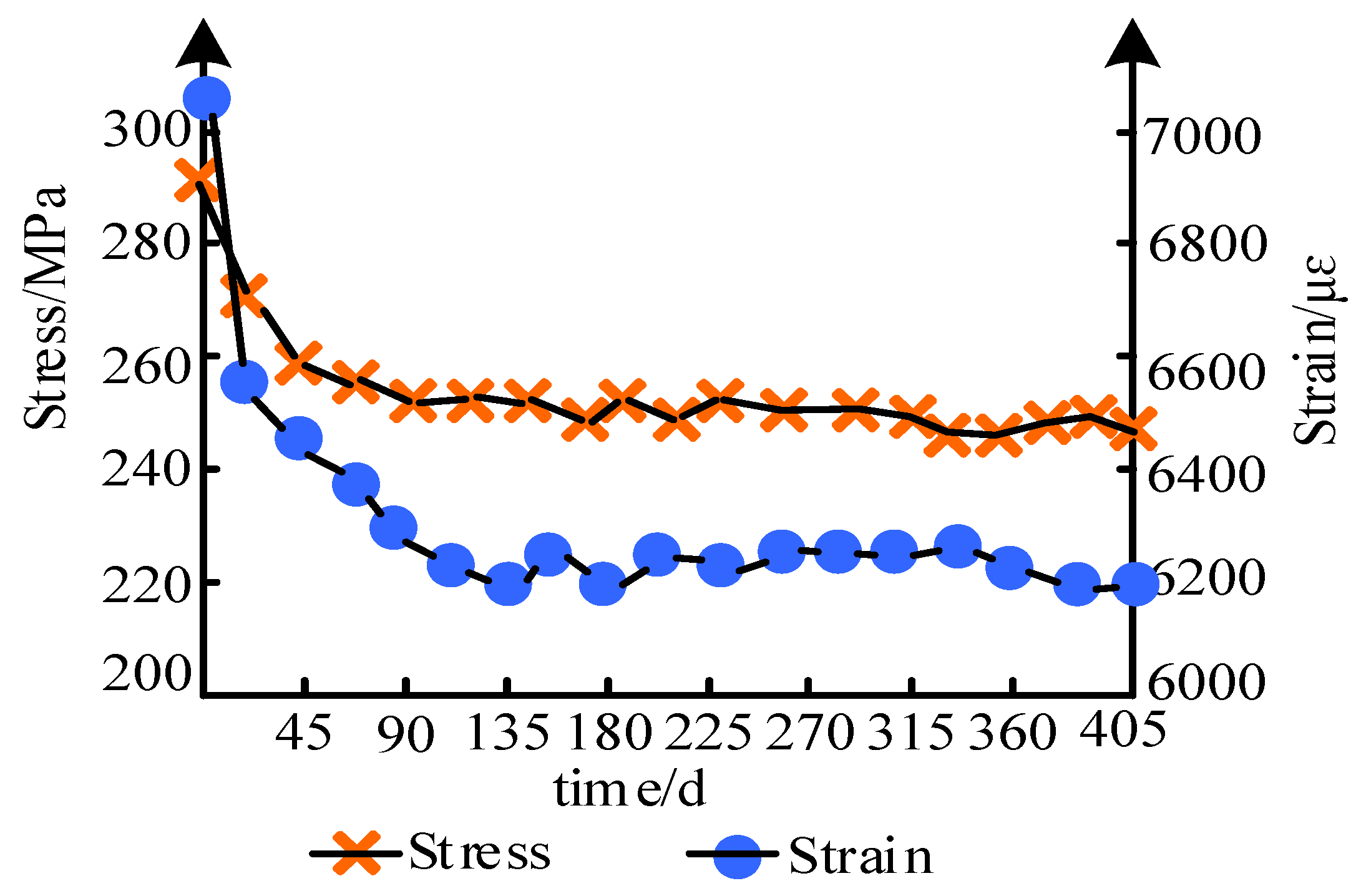
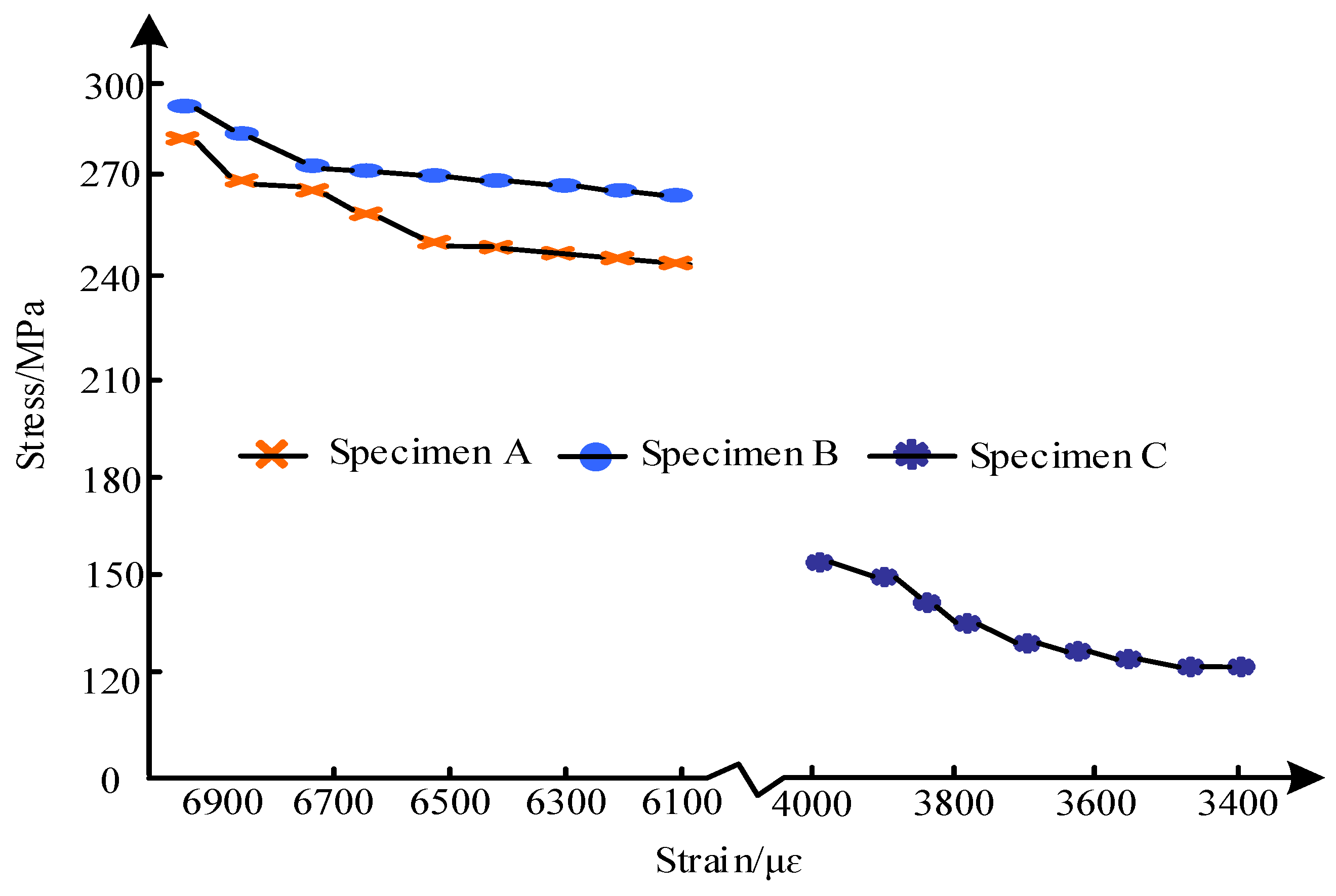
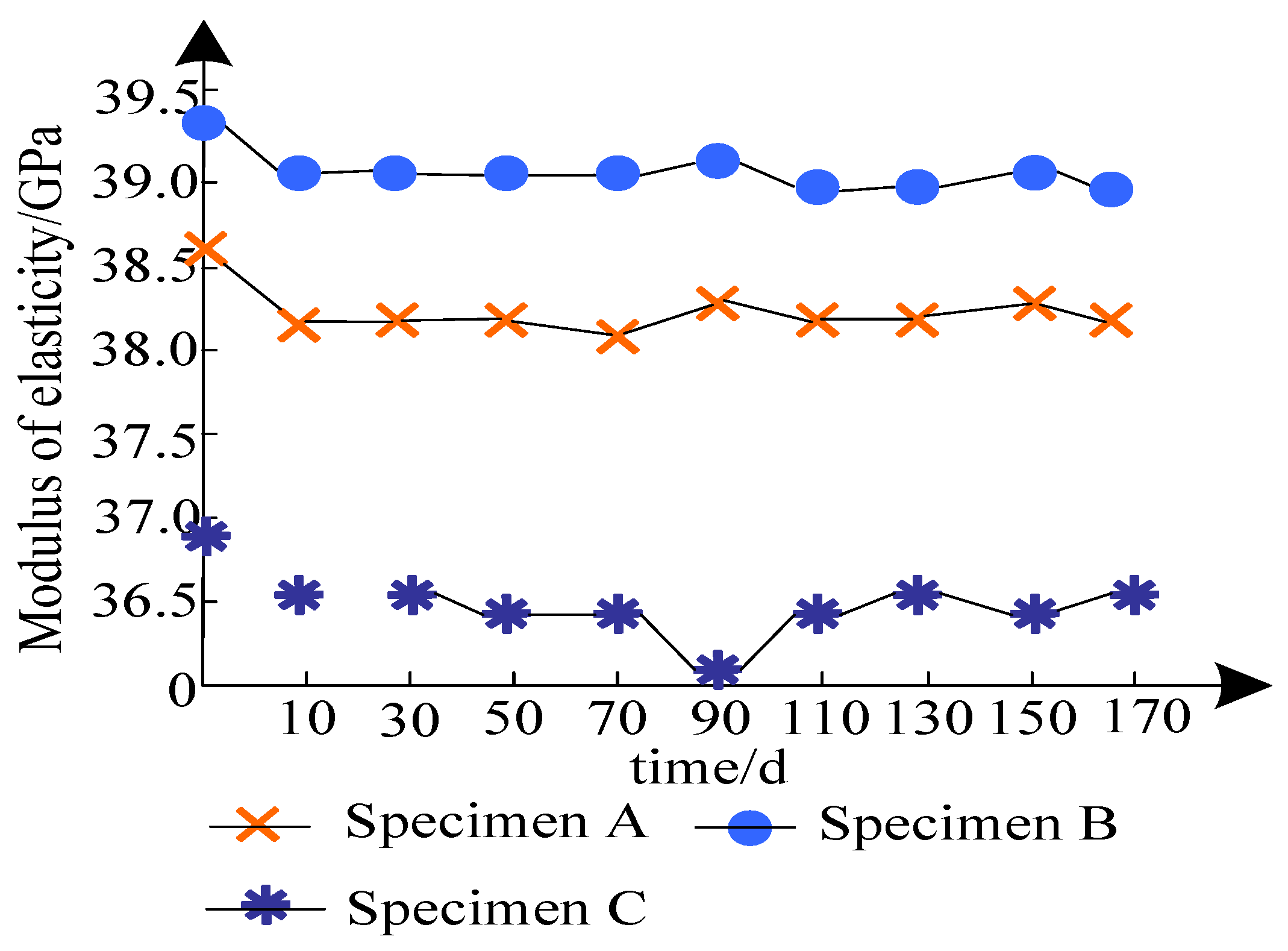

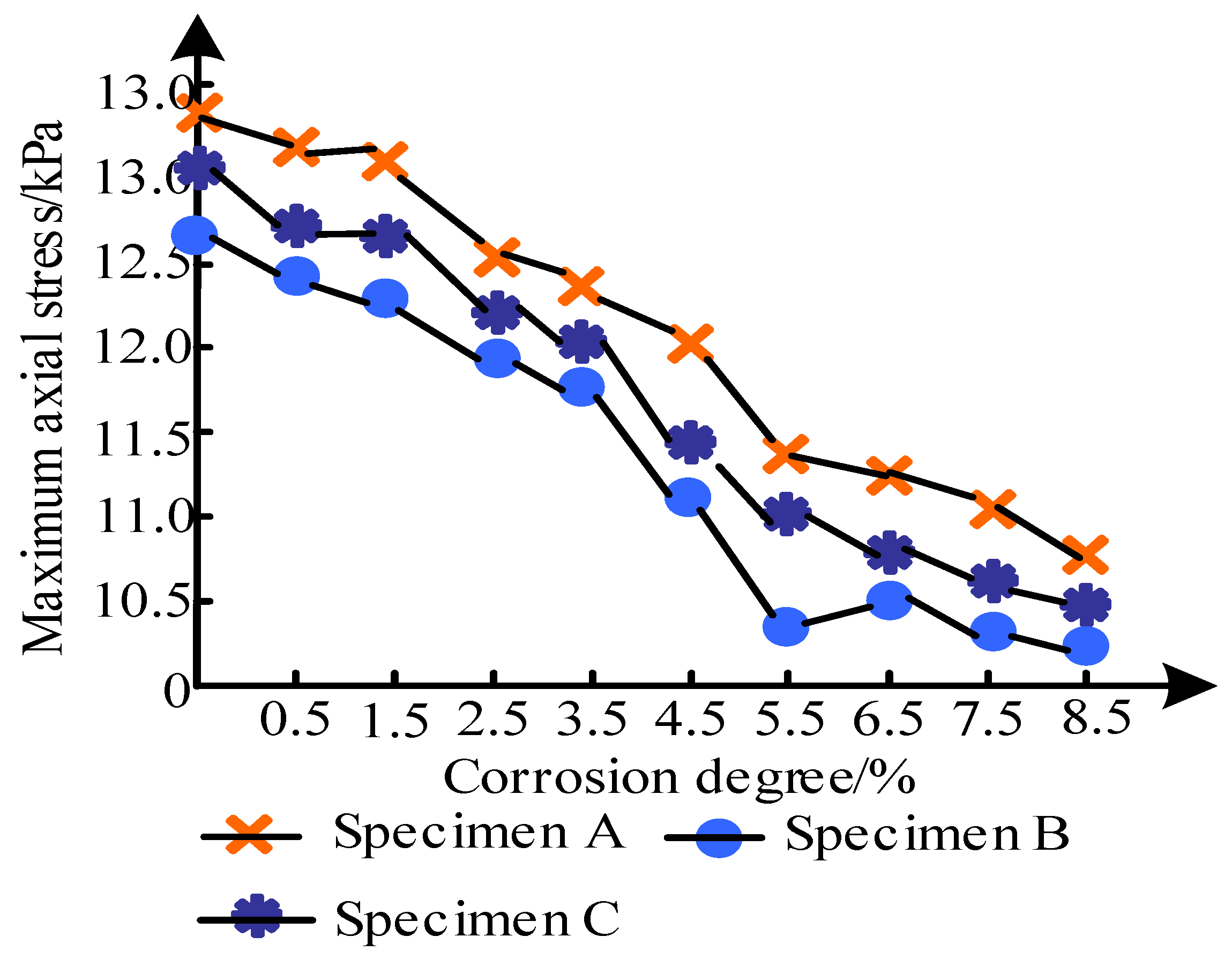
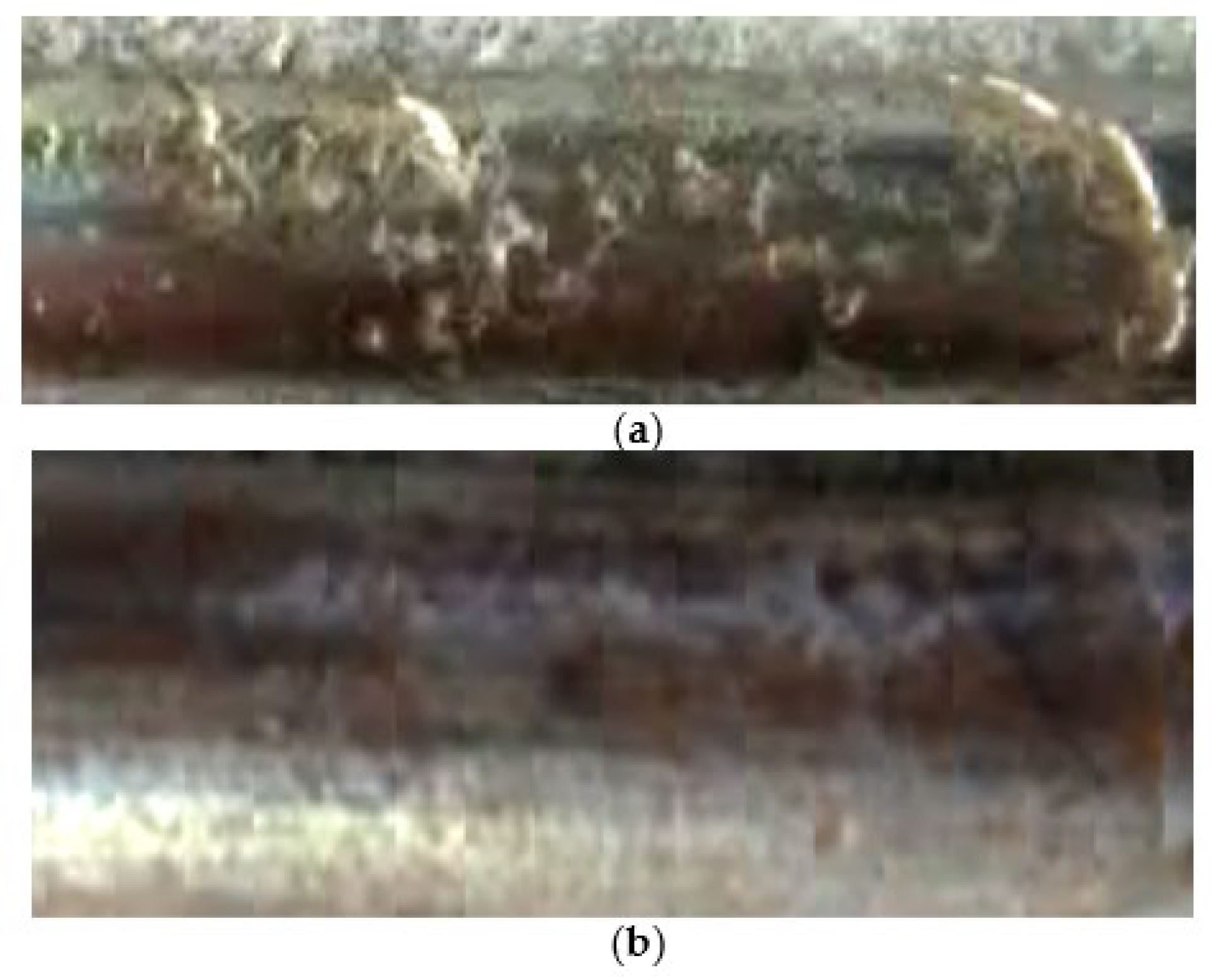

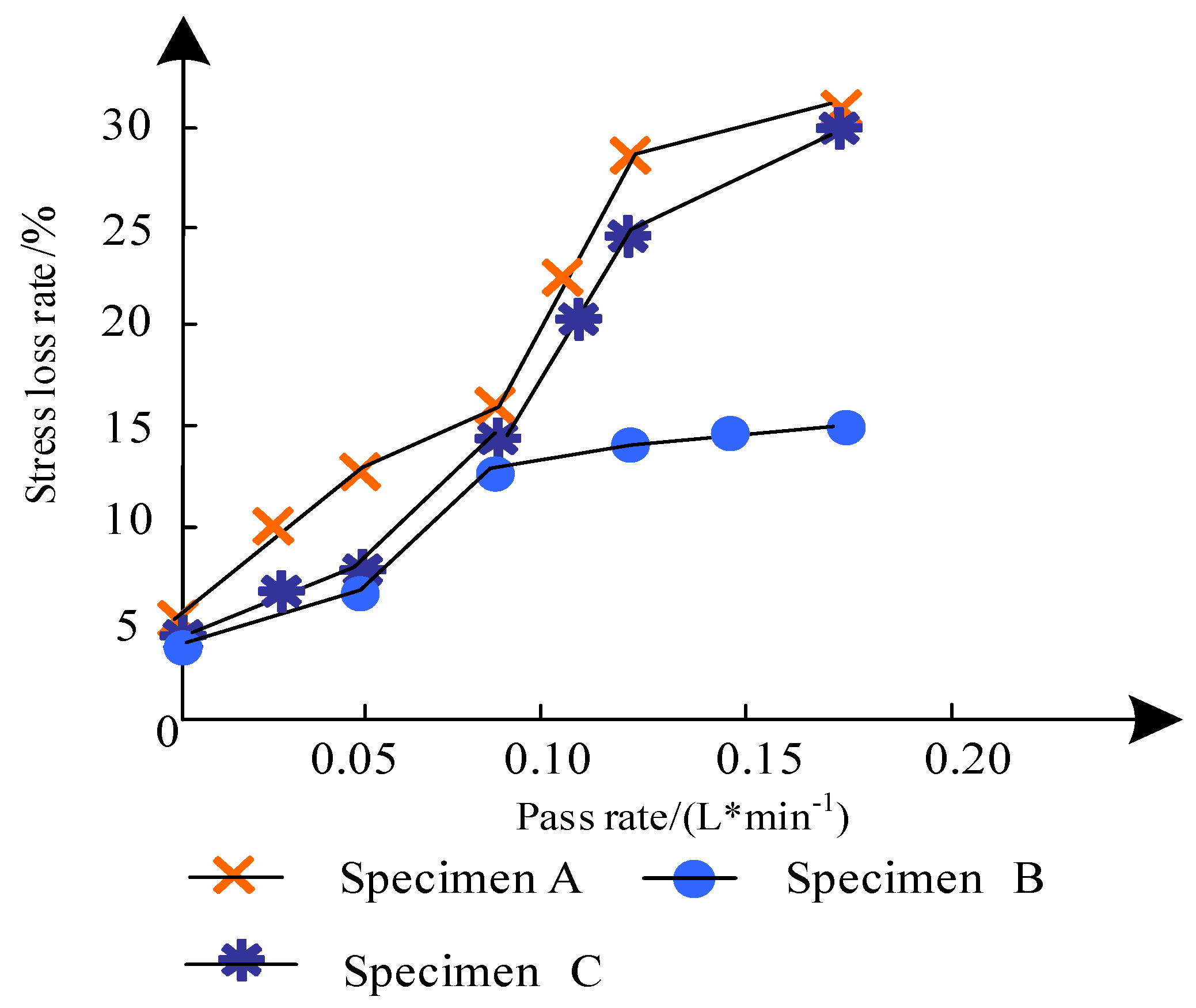
| Content | The Numerical | |
|---|---|---|
| The material composition | Resin/% | 19 |
| Glass fiber/% | 64 | |
| Basalt fiber/% | 10 | |
| Quartz sand/% | 7 | |
| Mechanical properties | Tensile strength/kN | 547.31 |
| Modulus of elasticity/GPa | 53.37 | |
| Elongation/% | 1.7 | |
| Specimen | Specimen A | Specimen B | Specimen C |
|---|---|---|---|
| The solution pH | 14 | 6.9 | 9 |
| The initial load value/kN | 170.2 | 185.3 | 89.9 |
| Condition Setting | Specimen A | Specimen B | Specimen C |
|---|---|---|---|
| pH value of solution | 14 | 6.9 | 9 |
| The initial load value/kN | 170.2 | 185.3 | 89.9 |
| The initial stress/MPa | 289.5 | 297.9 | 157.3 |
| Percentage of initial load and ultimate strength/% | 32.64 | 33.59 | 17.67 |
| Stress loss at 90 d/MPa | 26.5 | 22.0 | 13.6 |
| Stress loss at 360 d/MPa | 28.5 | 25.8 | 14.4 |
| Stress loss rate at 90 d/% | 9.23 | 7.75 | 5.23 |
| Stress loss rate at 360 d/% | 9.95 | 8.72 | 6.21 |
| Specimen | Specimen A | Specimen B | Specimen C |
|---|---|---|---|
| The solution pH | 14 | 6.9 | 9 |
| Load strength/ultimate strength/% | 32.64 | 33.59 | 17.67 |
| Initial elastic modulus/GPa | 42.6 | 43.8 | 38.8 |
| Loss of time/d | 75 | 24 | 73 |
| Modulus of elasticity after loss/GPa | 40.1 | 42.8 | 37.0 |
| Bolt strain after loss/μɛ | 6461 | 6575 | 3728 |
| The elastic modulus sharpens the stress loss rate/% | 3.76 | 2.36 | 2.01 |
| Bond sharpening stress loss rate/% | 6.21 | 6.47 | 7.22 |
| Pass Rate/(L·min−1) | Stressloss Rate of Specimen A/% | Stressloss Rate of Specimen B/% | Stressloss Rate of Specimen C/% |
|---|---|---|---|
| 0.00 | 5.51 | 3.48 | 4.48 |
| 0.05 | 12.77 | 6.74 | 8.34 |
| 0.09 | 16.48 | 12.17 | 14.57 |
| 0.13 | 27.58 | 13.56 | 25.61 |
| 0.17 | 29.26 | 14.35 | 28.42 |
Publisher’s Note: MDPI stays neutral with regard to jurisdictional claims in published maps and institutional affiliations. |
© 2022 by the authors. Licensee MDPI, Basel, Switzerland. This article is an open access article distributed under the terms and conditions of the Creative Commons Attribution (CC BY) license (https://creativecommons.org/licenses/by/4.0/).
Share and Cite
Liu, D.; Chen, A. Stress Loss Analysis of a Geotechnical Prestressed Anchor under a Corrosive Environment in a Coastal Area. Coatings 2022, 12, 1762. https://doi.org/10.3390/coatings12111762
Liu D, Chen A. Stress Loss Analysis of a Geotechnical Prestressed Anchor under a Corrosive Environment in a Coastal Area. Coatings. 2022; 12(11):1762. https://doi.org/10.3390/coatings12111762
Chicago/Turabian StyleLiu, Dandan, and An Chen. 2022. "Stress Loss Analysis of a Geotechnical Prestressed Anchor under a Corrosive Environment in a Coastal Area" Coatings 12, no. 11: 1762. https://doi.org/10.3390/coatings12111762
APA StyleLiu, D., & Chen, A. (2022). Stress Loss Analysis of a Geotechnical Prestressed Anchor under a Corrosive Environment in a Coastal Area. Coatings, 12(11), 1762. https://doi.org/10.3390/coatings12111762





